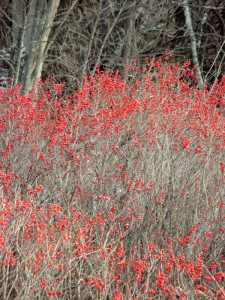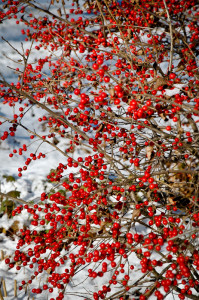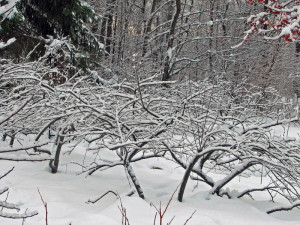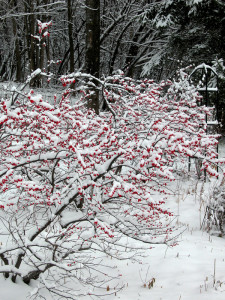New England’s Holly
The holly family…Ilex… is a large and familiar genus—over 400 species of trees and shrubs that inhabit woodlands in many parts of the world.
The holly of my youth was the ‘Christmas card’ holly— spiny, evergreen leaves and fat red berries. I can still remember the huge holly bushes in my parent’s garden—presumably they were the English Holly, Ilex aquifolium. As a child I felt they exuded a somewhat gloomy look and I disliked the prickly dead leaves that collected beneath them.
Most evergreen hollies— including smaller varieties like China Girl (and its counterpart China Boy) and the Blue Holly (Ilex meserveae)— are not hardy in much of northern New England. And in Zone 5—the limit of their hardiness—they need a sheltered spot to avoid winter burn.
But New England’s Winterberry is different
The winterberry, (Ilex verticillata), is also member of the Ilex family. It is native to New England and, with its bright red berries, makes a great addition to our winter gardens.
But unlike other Ilex species, Winterberries are deciduous…
…which means, as a defense against our much colder winters, in early November, all winterberry bushes drop their leaves, leaving each branch decorated with an amazingly abundant crop of berries.
The berries are a rich source of food for the birds, and surely a wonderful symbol of the season for us humans.
Wild winterberries
At this time of year I slow down at the sight of the huge colony of wild winterberries—also known as Black Alder—growing in a boggy spot at the side of Vermont Route 73, just east of Brandon.
Black alder grow in damp spots throughout New England. Most of the year they are just a tangled jumble of nondescript-looking bushes, but in November and December they become laden with bright red berries.
.
.
.
Taming the jumble:
winterberries in the garden
Winterberries also make beautiful garden plants, although we probably would not want such messy-looking jumble as you see along the road in anything but the wildest corner of our gardens.
So plant breeders have worked to develop a range of elegant garden-sized cultivars.
Winterberries are slow growing…but eventually most cultivars will spread to 8 foot high and wide or more…so space your plants accordingly!!
And it is important to remember that most species of Ilex are dioecious, meaning that the male and female flowers are borne on different plants. So, for your female bushes to set fruit, you need a compatible male variety that flowers at the same time.
A winterberry hedge
I wanted to create an informal hedge around the corner of the driveway where we park our cars. So, ten years ago now, I planted six ‘Winter Red’ female plants, eight feet apart, as an L-shaped hedge.
‘Winter Red’ flowers in June, and in the angle between the two sides, I added a single compatible male plant, ‘Southern Gentleman’, that also flowers in June.
Today the bushes take up plenty of space. They have spread out, low to the ground, in a wide vase shape about ten feet across, and stand about eight feet tall in the center.
For a small garden the cultivar ‘Red Sprite’—which grows about three feet high and wide—is an excellent choice. But I feel a single ‘Red Sprite’ on its own looks somewhat puny, so I plant them in groups, along with one compatible male, which in this case is ‘Jim Dandy’.
The controlling gardener!
Most gardening is, to a greater or lesser extent, about exerting partial control over nature. I generally like things to be a bit orderly and tidy and, even though I may want my gardens to be ‘wildlife friendly’, I sometimes resent wild creatures helping themselves to all the fruits of my labors.
Shapely shrubs…
a gardener’s delight
I love to see attractive shapes in the garden. So I select shrubs that will have simple silhouettes and further enhance them with careful pruning.
Most winterberry cultivars are inherently more elegant and shapely, and less inclined to put out myriad suckers, than the plants growing in the wild along the side of the road.
And their basic shapes can be further enhanced by careful pruning and removing unwanted suckers.
I still enjoy this sight of the arching silhouettes of our winterberry bushes in late winter, even though the berries are gone.
The battle of the robins
But nothing beats the picture of the brilliant red winterberry fruit against the snow.
Thus I feel especially protective of the berries on the bushes closest to the house.
Unfortunately, in early November, the robins gather in large flocks, eager to fill their bellies in preparation for their coming migration.
Many years a flock of robins will discover my winterberries and, over the course of five days, strip the bushes clean.
The robins are more than welcome to partake of winterberries growing near our pond, but I draw the line at those around the house.
However, scaring off a crowd of determined thieving robins can be a quite challenge, and over the years I have tried a number of different approaches:
I started by tying paper plates —with round ‘eyes’ painted in the middle– to the bushes.
Then I set fake owl on a post in the middle of the bushes.
After that I floated ‘Evil Eye‘ balloons above the bushes.
Nothing worked.
So this year we turned to NOISE MAKERS.
Banging a yogurt container against a garbage can lid certainly sent the robins flying….but I still had to run outside each time they returned.
.
.
.
.
.
And then Dick had the brilliant idea of activating the car horn remotely from the house!!
AND FINALLY SUCCESS….
The car horn is now our remote-controlled bird scarer.
And I get to feel like the ultimate control freak!!!





